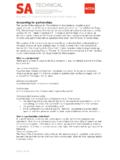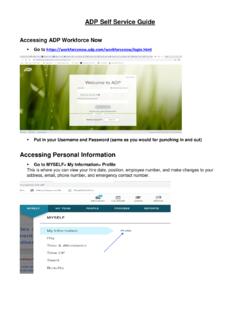Transcription of ICT A BRIEF INTRODUCTION - Project GoodWill
1 ICT A BRIEF INTRODUCTION TOPICS: What is ICT? Where does ICT literacy begin What skills makes one an ICT literate Why is ICT so important What are the fundamental elements of ICT How do you create information How do you store information How do you transmit or send information How do you retrieve and manipulate information How to you interpret information How does one acquire ICT skills WHAT IS ICT? ICT is short for Information & Communications Technology. ICT covers all forms of Computer and Communications equipment as well as the software used to create, store, transmit, receive, interpret, and manipulate information in its various formats. Information comes in various formats and it is all around us: Voice Conversation Text pictures Data Motion Pictures or Video Multimedia Presentations Radio and Wireless Broadcast Television Broadcast ICT deals with all the systems involved in creating, storing, sending or transmitting, receiving and manipulating these kinds of information.
2 The systems behind ICT include both hardware devices and the software that allow the hardware devices to carry out or to be used for their intended functions. Hardware is the physical parts of the system that one can see and touch. For example the Computer s CPU is a hardware aspect of the Computer system. The Computer s Display or Monitor is another hardware component of the Computer system. For the Computer to perform its function there are programs or software aspects that work together with the hardware components to make the Computer usable. A Computer needs software to help create and manipulate information such as text, data, picture or video. To manipulate information such as print a document, the Computer needs to have a printer software running that can communicate with the printer (hardware).
3 The printer software, also known as printer driver, tells the printer what to print, how to print and when to print it. Without this software you will not be able to print hard copies of your document on paper. WHERE DOES ICT LITERACY BEGIN? ICT know-how begins with Computer Literacy. Nowadays Computers can be found in a lot of places apart from individual homes. Computers are being used at workplaces, in schools, libraries and businesses to accomplish a variety of tasks at a fraction of the time that it took to accomplish those same tasks long before the INTRODUCTION of Computers. Computers help us accomplish more in less time and more efficiently. Computers have made us more productive than ever before. Being a Computer literate has become very important in the world these days.
4 Computer Literacy enables people to acquire the basic skills and knowledge to be part of the workforce in any ICT equipped environment. Computer Literacy has created and continues to create many job opportunities for people. Skills in ICT provides opportunities for people to work with one another as well as independently to undertake and accomplish different tasks. Thanks to developments in ICT you can now compose and send messages to friends and family as wells as to colleagues at work with the help of electronic mail applications and ICT networks such as the Internet. Text messaging to friends and families using various mobile devices has become the order of the day. Video Conferencing for important meetings across the globe is now possible. In summary the knowledge and use of Computers is at the core of ICT literacy and skill building.
5 WHAT SKILLS MAKES ONE AN ICT LITERATE? Information and Communications Technology (ICT) covers a wide range of systems and technologies and an individual does not need to know all these systems and technologies in order to be considered as an literate. To be considered an ICT literate one needs to acquire various ICT skills that include but not limited to the following: Must understand and be able to use a Computer to perform various tasks such as opening applications, creating and modifying documents, spreadsheets or presentations. Some basic typing skills will be necessary. Have the ability to identify various ICT technologies and their uses. Understand ICT technologies and concepts and be able to decide which ICT technology will be suitable for a particular task. Ability to differentiate between various forms of information and understand how to use or manipulate them.
6 WHY is ICT important? Information and Communication Technology (ICT) is all around us. We encounter some elements of ICT in our day-to-day lives. In offices, schools, libraries, industries and homes ICT is increasingly being used. It has become progressively more important to acquire skills in ICT for several reasons. Acquiring skills, knowledge and understanding in the use of ICT systems prepares people to use such technologies to accomplish various tasks in their everyday lives as well as in their working lives. ICT technologies such as the Internet enables people to access and share information. Distant learning and online education has become the order of the day thanks to advancements in ICT. The knowledge of ICT provides opportunities for people to work both collaboratively and independently in completing different tasks.
7 Companies are able to reduce cost of operations and improve efficiency by using the right ICT systems to conduct their businesses. With the appropriate ICT systems, information and data can be stored and retrieved more efficiently and reliably. The application of ICT to accomplish tasks is not limited to any particular business or industry. Whether you are a teacher, student, doctor, nurse, accountant, architect or engineer there is a great chance that you are currently using Computers or will be doing so in the near future to perform various duties in your field. What are the fundamental elements of ICT The basic components of an ICT system include devices such as Computers and Communications equipment and networks used to create, store, retrieve, send and receive information. A Computer can be used to create, store or change information.
8 Communication devices such as modems, routers, switches and hubs that are connected to Computer systems help to transmit and receive information to and from other Computers and ICT systems. Communication devices simply allow Computers and various ICT systems to be connected to one another. They facilitate the transmission and receiving of information and data over the transmission media that link them to each other. Examples of Transmission Media are: Cables (Copper or Fiber) Telephone Lines Cellular or Mobile Links (through open space, wireless) Satellite Links (though open space) Communication devices and the infrastructure or transmission media that link them together constitute Communication Networks. What are Communications Networks? In order to send and receive information you need some kind of infrastructure or network in place to transport the information back and forth.
9 This is the communications network. A Communications Network is made up of connected Communications devices and the transmission media that link them together. The are various forms of communications networks: Local Area Networks Wide Area Networks The Internet Satellite Links Telephone Networks The Internet has become a major communications and information distribution network. Below are some illustrations of the above forms of Communication Networks: LOCAL AREA NETWORK PC Workstation Laptop Database Server File Server Email ServerPC WorkstationPC WorkstationPC WorkstationLOCAL AREA NETWORKPC Workstation In the Local Area Network (LAN) above any PC Workstation is able to retrieve or store files on the file server. The workstations can also send electronic mail (email) to one another through the Email Server.
10 Important data can be stored in records on the Database Server. WIDE AREA NETWORK LAN-A````LAN-B```Main OfficeBranch OfficeCommunications LinkCommunications Link The Wide Area Network is an expansion of the Local Area Network. In addition to information exchanges between Computers inside the same building, data transfers and email can now be transmitted over long distance across town, between two cites or even two continents. THE INTERNET INTERNET`ModemWireless Access PointWireless LaptopInternet ResourceInternet Resource`Router The Internet is the Network of Networks that has extended our global reach to resources all over the world. A SIMPLE CELLULAR NETWORK Mobile-CCell TowerMobile-DMobile-BMobile-AWireless Laptop How do you create information?









